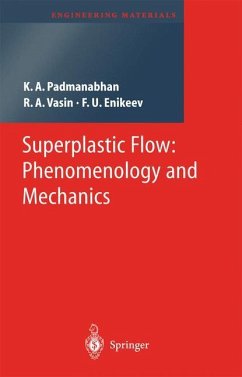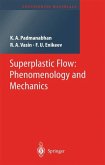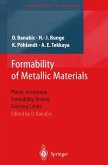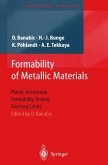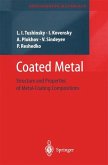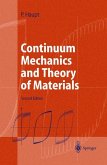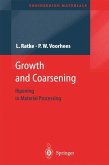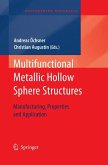This book is intended for a variety of readers who may be interested in the phenomenon of superplasticity for different reasons: materials scientists and physicists working in educational institutions and R&D units, those who wish to work on the applications of superplasticity, engineers in industry, students at senior undergraduate and postgraduate levels and those who wish to understand the phenomenology and mechanics of superplasticity without involvement in actual research. A reader who has exposure to standard differential and integral calculus and elementary tensor calculus at a level taught to senior undergraduate students at a technical university should have no difficulty in following the treatments. The analytical procedures are explained in an appendix with simple examples.
Superplasticity is the ability of polycrystalline materials under certain conditions to exhibit extreme tensile elongation in a nearly homogeneous/isotropic manner. Historically, this phenomenon was discovered and systematically studied by metallurgists and physicists. They, along with practising engineers, used materials in the superplastic state for materials forming applications. Metallurgists concluded that they had the necessary information on superplasticity and so theoretical studies focussed mostly on understanding the physical and metallurgi cal properties of superplastic materials. Practical applications, in contrast, were led by empirical approaches, rules of thumb and creative design. It has become clear that mathematical models of superplastic deformation as well as analyses for metal working processes that exploit the superplastic state are not adequate. A systematic approach based on the methods of mechanics of solids is likely to prove useful in improving the situation. The present book aims at the following. 1. Outline briefly the techniques of mechanics of solids, particularly as it applies to strain rate sensitive materials. 2. Assess the present level of investigations on the mechanical behaviour of superplastics. 3. Formulate the main issues and challenges in mechanics ofsuperplasticity. 4. Analyse the mathematical models/constitutive equations for superplastic flow from the viewpoint of mechanics. 5. Review the models of superplastic metal working processes. 6. Indicate with examples new results that may be obtained using the methods of mechanics of solids.
Superplasticity is the ability of polycrystalline materials under certain conditions to exhibit extreme tensile elongation in a nearly homogeneous/isotropic manner. Historically, this phenomenon was discovered and systematically studied by metallurgists and physicists. They, along with practising engineers, used materials in the superplastic state for materials forming applications. Metallurgists concluded that they had the necessary information on superplasticity and so theoretical studies focussed mostly on understanding the physical and metallurgi cal properties of superplastic materials. Practical applications, in contrast, were led by empirical approaches, rules of thumb and creative design. It has become clear that mathematical models of superplastic deformation as well as analyses for metal working processes that exploit the superplastic state are not adequate. A systematic approach based on the methods of mechanics of solids is likely to prove useful in improving the situation. The present book aims at the following. 1. Outline briefly the techniques of mechanics of solids, particularly as it applies to strain rate sensitive materials. 2. Assess the present level of investigations on the mechanical behaviour of superplastics. 3. Formulate the main issues and challenges in mechanics ofsuperplasticity. 4. Analyse the mathematical models/constitutive equations for superplastic flow from the viewpoint of mechanics. 5. Review the models of superplastic metal working processes. 6. Indicate with examples new results that may be obtained using the methods of mechanics of solids.
From the reviews:
"The book under review ... is another book in the same direction to unify the two approaches to studying mechanical behaviour of materials but with a focus on the specific area of superplastic flow and forming. ... There are four Appendices totaling to 60 pages ... . These ... greatly enhance the usefulness of the book. The book is a welcome addition to the literature on superplasticity and is a must-read to all those who want to study, understand, research and engineer superplastic flow." (Placid Rodriguez, Transactions of the Indian Institute of Metals, April, 2003)
"The book under review develops in a systematic manner, the linkages between phenomenology and mechanics. ... the authors discuss the various constitutive equations available for superplastic flow and boundary-value problems with superplastic forming. ... the book contains four appendices that provide useful background information ... . In summary, the book is well produced, with good quality figures and equations, and it is likely to be useful for practising technologists and also at a post-graduate level in teaching/research programmes ... ." (Atul H. Chokshi, Current Science, Vol. 84 (4), 2003)
"The aim of this monograph is ... establishing the mechanics of superplasticity as a discipline in its own right. ... a rather comprehensive overview is given on the multitude of superplastics material models available, particularly focusing on technological applications, which clearly certifies the authors' competence in the field. The strength of the book is the compilation of numerous important references (621 explicitly cited) ... . There is a lot to learn from this book." (Dr. Eva Gregorová, Materials World, Vol. 10 (4), 2002)
"The book under review ... is another book in the same direction to unify the two approaches to studying mechanical behaviour of materials but with a focus on the specific area of superplastic flow and forming. ... There are four Appendices totaling to 60 pages ... . These ... greatly enhance the usefulness of the book. The book is a welcome addition to the literature on superplasticity and is a must-read to all those who want to study, understand, research and engineer superplastic flow." (Placid Rodriguez, Transactions of the Indian Institute of Metals, April, 2003)
"The book under review develops in a systematic manner, the linkages between phenomenology and mechanics. ... the authors discuss the various constitutive equations available for superplastic flow and boundary-value problems with superplastic forming. ... the book contains four appendices that provide useful background information ... . In summary, the book is well produced, with good quality figures and equations, and it is likely to be useful for practising technologists and also at a post-graduate level in teaching/research programmes ... ." (Atul H. Chokshi, Current Science, Vol. 84 (4), 2003)
"The aim of this monograph is ... establishing the mechanics of superplasticity as a discipline in its own right. ... a rather comprehensive overview is given on the multitude of superplastics material models available, particularly focusing on technological applications, which clearly certifies the authors' competence in the field. The strength of the book is the compilation of numerous important references (621 explicitly cited) ... . There is a lot to learn from this book." (Dr. Eva Gregorová, Materials World, Vol. 10 (4), 2002)

